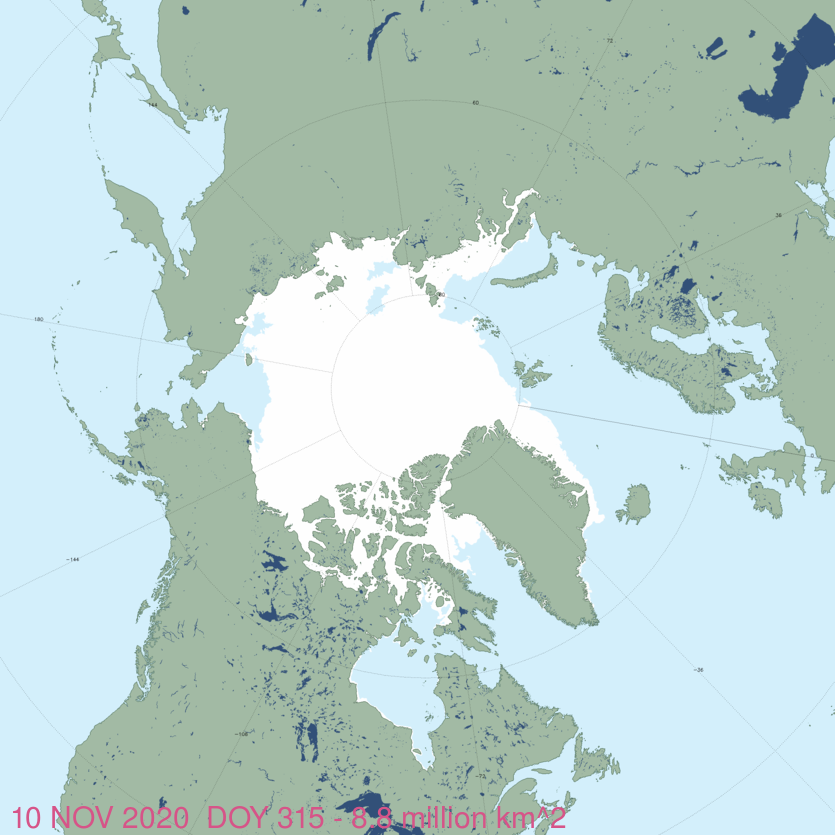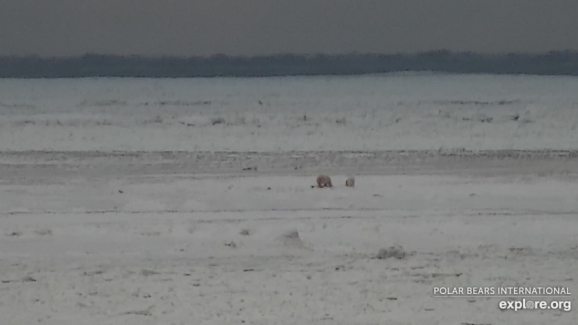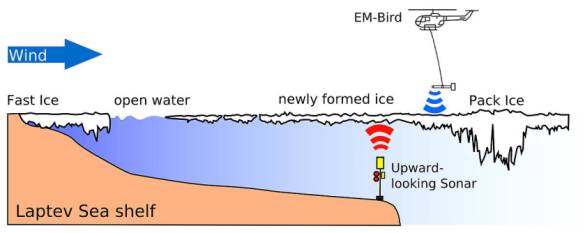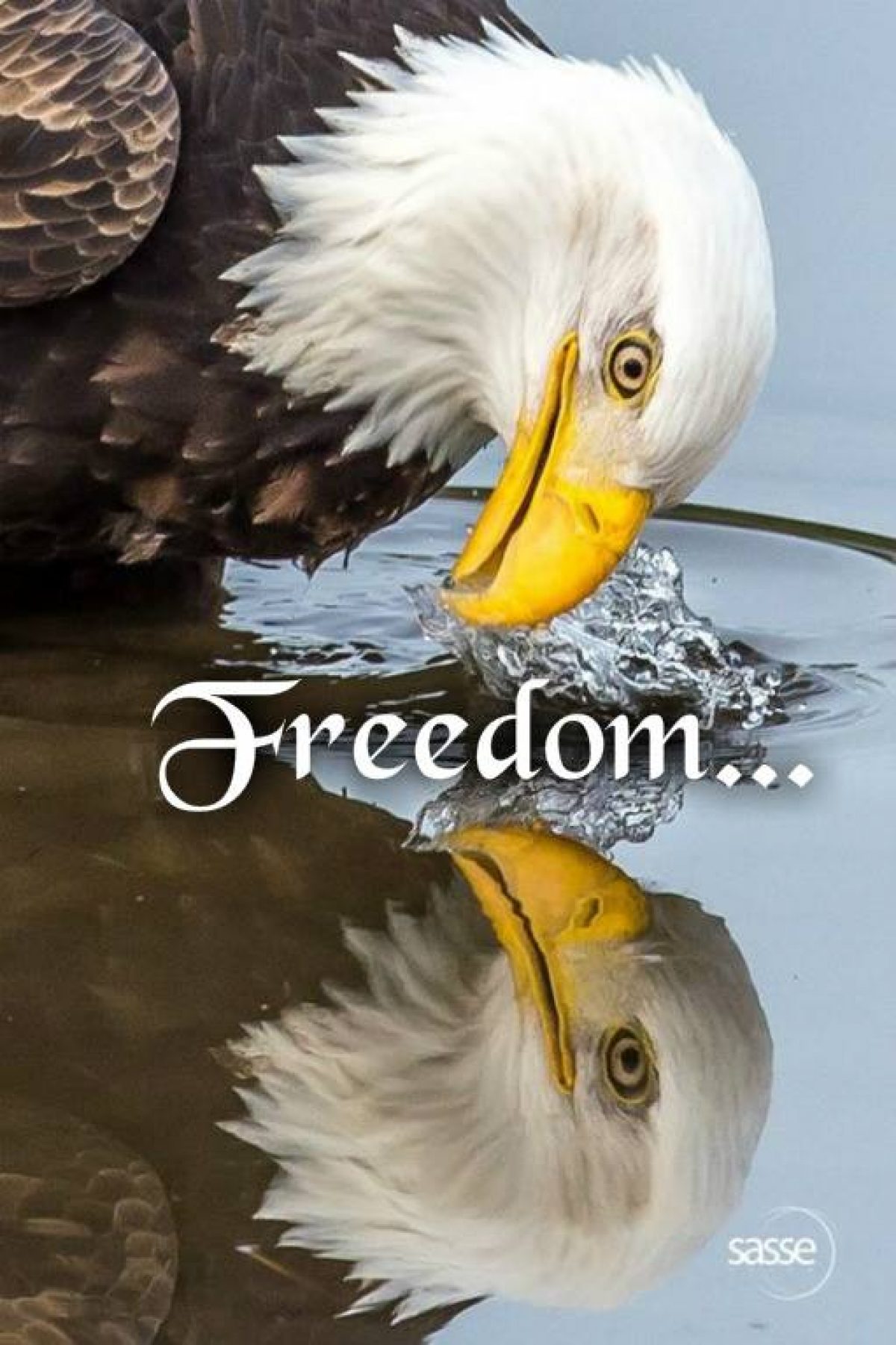Reposted from Polar Bear Science
Posted on November 11, 2020 |
What may seem like a silly question is actually fundamental to polar bear survival: in the fall, why do Western Hudson Bay bears correctly expect to find seals in the new ice that forms offshore? Why are seals attracted to that new ice – called ‘shorefast ice’ or ‘fast ice’ – when they would clearly be safer out in the open water where there is no ice and no bears?
As the picture below attests, polar bears can and do kill ringed seals in the new ice that forms off the coast of Western Hudson Bay even when it is but a narrow strip of thin ice – and so close to shore their successes can be caught on camera.

A different bear was also filmed killing another seal on 31 October. And these are only the kills we know about along a very short stretch of coast – the killing is almost certainly going on up and down the entire coast, into James Bay (see below), where there is just as much ice but no cameras.

As far as I am aware, this seal killing by polar bears goes on in newly-formed shorefast ice everywhere across the Arctic in early fall, not just in Hudson Bay. Although the timing varies, virtually everywhere in the peripheral seas of the Arctic Ocean (Barents, Kara, Laptev, Chukchi, Beaufort, as well as Baffin Bay and Davis Strait), shorefast ice forms before the mobile ice pack expands to meet the ice developing from shore.

This shorefast ice formation in fall provides a predictable but short-lived source of prey for polar bears as they strive to regain some of the weight lost over the summer.
SHOREFAST ICE ATTRACTS SEALS IN FALL
Not a single paper on polar bear or ringed seal ecology that I’ve found states clearly why seals are so attracted to newly-formed ice in the fall that they make themselves easy prey for polar bears.
Ian Stirling, for example, has discussed the enhanced biological productivity of ice-edge habitats of recurring polynyas and recurring shore leads (or flaw edge polynyas), but does not specifically mention why newly-formed ice edges in fall are such a productive seal habitat (Stirling and Oritsland 1995:2596; Stirling et al. 1977). Several authors (e.g. Castro de la Guardia et al. 2017; Obbard et al. 2016:29) mention that polar bears move onto thin shorefast ice in the fall almost as soon as it forms and indicate there is evidence they kill seals in this habitat. But they do not explain any further.
Seal biologist don’t do much better. Magaly Chambellant (2010:148) states that adult ringed seals move inshore as ice forms in the fall in order to set up breeding territories:
“When the ice starts to form in late fall, adults gather close to shore to establish territories (McLaren 1958; Smith 1987). During this period, juveniles are actively excluded from these habitats (McLaren 1958; Smith 1987; Holst et al. 1999; Krafft et al. 2007).”
But as I show below, the authors Chamballant cites suggests this summarization may not be strictly true or at least, not entirely true for the entire early freeze-up period. For example, McLaren (1958:72) commented on the movement of ringed seals at freeze-up along the coast of Baffin Bay and indicated that Inuit informants said the draw of new ice for young seals is initially as a haulout platform, but that they are then driven out of the expanding habitat by adults preparing to set up winter (breeding) territories [my bold]:
“According to the natives , the fall movement of young seals is analogous to the spring movement, where the desire to haul out on the fast ice seems to be the chief cause. As the nights lengthen and the days become cold, fewer seals are seen sunning on the ice. Most young seals move out with the progressing ice edge, leaving the adults in their winter residence under the fast ice.“
Similarly, Smith (1987:8-15), said this [my bold]:
“In the autumn, usually 3 weeks to a month prior to freeze-up, there appears to be an influx of ringed seals into the Prince Albert Sound area. … Seals during this period are usually found in groups, sometimes numbering upwards of 30 individuals, and are very old consisting mostly of adults with few adolescents and rarely any young-of-the-year. This is the only time of year when ringed seals are seen together in the water. They are feeding intensely on dense schools of arctic cod which are found in the area at this time in most years. … From observations in the late autumn just before or during freeze up large groups of adult ringed seals are seen to move into these areas which will later become breeding habitat. The age structure of these groups of adult males and females collected during October 1971 and 1973 is very similar to the age of seals taken in the breeding habitat of the same area the following spring.”
In other words, it appears that at least in some areas (and perhaps all) there is an initial movement of fish to the near shore area just prior to and during the early stages of freeze-up which attracts seals of all ages (but perhaps few young-of-the-year), some of whom may haul out on the new ice and make themselves available as polar bear prey.
As this new ice thickens and expands away from shore, adult seals establishing breeding territories in advance of the winter season come to dominate the shorefast ice habitat but predator-savvy adults are much harder for polar bears to catch than younger seals. Adult male ringed seals are extremely territorial in this shorefast ice habitat, a topic I examined in depth in a recent scientific paper (Crockford and Frederick 2011), but whether this territorial focus makes these seals more or less vigilant to the risk of predation by polar bears is not clear.
Overall, it seems no one has examined in detail what is going on in the newly-formed shorefast ice. For good reason, I have to admit: new sea ice tends to be unstable and unpredictable underfoot for safe human travel and too thin for landing a helicopter. Inevitably, shore-based cameras like those installed in Wakusp National Park or photos taken by dedicated shore-bound observers are the only record we have of the hunting and killing of seals by polar bears and this evidence ceases to be collected when the bears move beyond the range of these cameras.

WHAT ATTRACTS SEALS TO NEW SHOREFAST ICE?
Even the folks studying physical processes do not explicitly state (anywhere that I could find) precisely what happens to attract seals to newly formed ice. However, based on the descriptions of the processes, it seems the cooling process necessary for sea ice formation along the shore of Arctic regions, including the west coast of Hudson Bay, initially creates an underwater current that brings nutrients from deeper, saltier water up to the surface (‘upwelling’). The process of early ice formation also involves vertical movement of ice crystals in the water column, enhancing this upwelling (Buckley et al. 1979). This transient fall coastal upwelling brings nutrients near the surface for single-cell organisms that are food for fish. A similar process goes on in Arctic polynyas – areas of open water surrounded by sea ice that attract polar bears and a variety of other wildlife during late winter and early spring (Dunbar 1981; Stirling 1997; Stirling et al. 1981; Tremblay et al. 2012).
As fish congregate briefly to feed near the surface close to shore, ringed seals of all ages congregate as well – all along the edges and underneath the ice that begins to form. When this new fast ice becomes thick enough for a polar bear to stand upon (about 30 cm thick) – either through continued ice formation or because the ice has been buckled and deformed by winds and tides into thickened ridges – some seals may haul out to rest or come to the surface to breath and become prey for hungry bears.

SEALS ARE A PREDICTABLE RESOURCE IN FALL
This inevitable process of shorefast ice formation takes place every fall across the Arctic and it’s why polar bears know they can hunt successfully out on the new fast ice after months without food over the summer. It’s almost certainly why the bears head out on the ice as soon as it’s physically possible for them to do so – they know they will find seals there.
I suggest, therefore, that fall is the second-most important feeding season after spring (Stirling and Oritsland 1997) because the presence of seals is predictable and allows polar bears to regain some of the weight they have lost over the summer. However, while the presence of seals in new fast ice in fall is as predictable as are newborn seals in spring, the fall feeding season is much shorter: the fall feeding window is weeks rather than months long.
And what comes after the fall feeding is winter: the most dangerous time of the year for polar bears because hunting opportunities are unpredictable (i.e. few and far between). Starvation is the leading natural cause of death for polar bears and most bears that die of starvation do so during the depth of winter, without human witnesses. The huge and predictable crop of newborn seals in the spring saves the lives of those bears that have only just made it through the winter, fattens up all age classes enough to survive the summer ice-free fast and allows mature females to get fat enough to maintain a pregnancy later in the year. And with this spring feeding, the lives of most polar bears are assured for another year.
VIDEO: Polar Bear Testing New Shorefast Ice off Wapusk National Park, Western Hudson Bay, November 5, 2020 (below):
SHOREFAST ICE ACROSS THE ARCTIC
Virtually everywhere in the peripheral seas of the Arctic Ocean (Barents, Kara, Laptev, Chukchi, Beaufort, as well as Baffin Bay and Davis Strait, shorefast ice thick enough to support a polar bear forms before the mobile ice pack in the central Arctic expands to the shores of the peripheral seas (below).

For example, although most years the pack ice doesn’t move very far away from the Russian shore in summer, this year was different – leading our most socially-vocal polar bear ‘expert’ to express his worry for the fate of Russian bears.https://platform.twitter.com/embed/index.html?creatorScreenName=wattsupwiththat&dnt=true&embedId=twitter-widget-0&frame=false&hideCard=false&hideThread=false&id=1318288825349677056&lang=en&origin=https%3A%2F%2Fwattsupwiththat.com%2F2020%2F11%2F13%2Fshorefast-ice-formation-and-the-fall-feeding-season-for-polar-bear%2F&siteScreenName=WattsUpWithThat&theme=light&widgetsVersion=ed20a2b%3A1601588405575&width=550px
Even without being able to see it happening, it is certain that shorefast ice development was providing critical habitat for seals and polar bears along the Russian coast this fall by late October (below).
Shorefast ice development along the Laptev and Kara Seas at 27 October 2020, NSIDC Masie.

By this time, there was plenty of ice at the edge of the Laptev Sea for polar bears that had spent the summer on shore to resume feeding, both along the mainland and on offshore islands – even though the Arctic pack ice was still a long distance offshore.
Despite knowing full well that shore-bound polar bears can use new shorefast ice as a successful hunting platform wherever it develops over shallow continental shelves in the Arctic, Derocher implies a few weeks later that Laptev Sea bears are not able to hunt until the pack ice returns, as it did in early November:https://platform.twitter.com/embed/index.html?creatorScreenName=wattsupwiththat&dnt=true&embedId=twitter-widget-1&frame=false&hideCard=false&hideThread=false&id=1325829159369601024&lang=en&origin=https%3A%2F%2Fwattsupwiththat.com%2F2020%2F11%2F13%2Fshorefast-ice-formation-and-the-fall-feeding-season-for-polar-bear%2F&siteScreenName=WattsUpWithThat&theme=light&widgetsVersion=ed20a2b%3A1601588405575&width=550px
Bottom line: Shorefast ice formation that leads to the predictable but short-lived presence of ringed seals explains why fall is the second-most important feeding period for polar bears throughout the Arctic.
REFERENCES
Buckley, J.R., Gammelsrod, T., Johannessen, O.M. and Roed, L.P. 1979. Upwelling: Oceanic structure at the Arctic ice pack in winter. Science 203 (4376):165-167. DOI: 10.1126/science.203.4376.165
Castro de la Guardia, L., Myers, P.G., Derocher, A.E., Lunn, N.J., Terwisscha van Scheltinga, A.D. 2017. Sea ice cycle in western Hudson Bay, Canada, from a polar bear perspective. Marine Ecology Progress Series 564: 225–233. http://www.int-res.com/abstracts/meps/v564/p225-233/
Chambellant, M. 2010. Hudson Bay ringed seal: ecology in a warming climate. In S.H. Ferguson et al. (eds.), A Little Less Arctic: Top Predators in the World’s Largest Northern Inland Sea, Hudson Bay, Springer Science+Business Media B.V. DOI 10.1007/978-90-481-9121-5_7
Crockford, S.J. and Frederick, G. 2011. Neoglacial sea ice and life history flexibility in ringed and fur seals. pg. 65-91 In, T. Braje and R. Torrey, eds. Human and Marine Ecosystems: Archaeology and Historical Ecology of Northeastern Pacific Seals, Sea Lions, and Sea Otters. U. California Press, LA.
Dunbar, M.J. 1981. Physical causes and biological significance of polynyas and other open water in sea ice. In: Polynyas in the Canadian Arctic, Stirling, I. and Cleator, H. (eds), pg. 29-43. Canadian Wildlife Service, Occasional Paper No. 45. Ottawa.
McLaren, I.A. 1958. The biology of the ringed seal (Phoca hispida Schreber) in the Eastern Canadian Arctic. Fisheries Research Board of Canada, Ottawa. Bulletin 118. Pdf here.
Obbard, M.E., Cattet, M.R.I., Howe, E.J., Middel, K.R., Newton, E.J., Kolenosky, G.B., Abraham, K.F. and Greenwood, C.J. 2016. Trends in body condition in polar bears (Ursus maritimus) from the Southern Hudson Bay subpopulation in relation to changes in sea ice. Arctic Science 2: 15-32. DOI: 10.1139/AS-2015-0027
Smith, T.G. 1987. The ringed seal, Phoca hispida, of the Canadian western Arctic. Canadian Bulletin of Fisheries and Aquatic Sciences 216.
Stirling, I. 1997. The importance of polynyas, ice edges, and leads to marine mammals and birds. Journal of Marine Systems 10: 9-21.
Stirling I, Jonkel C, Smith P, Robertson R, Cross D. 1977. The ecology of the polar bear (Ursus maritimus) along the western coast of Hudson Bay. Canadian Wildlife Service Occasional Paper No. 33. pdf here.
Stirling, I. and Øritsland, N. A. 1995. Relationships between estimates of ringed seal (Phoca hispida) and polar bear (Ursus maritimus) populations in the Canadian Arctic. Canadian Journal of Fisheries and Aquatic Sciences 52: 2594 – 2612. http://www.nrcresearchpress.com/doi/abs/10.1139/f95-849#.VNep0y5v_gU
Stirling, I, Cleator, H. and Smith, T.G. 1981. Marine mammals. In: Polynyas in the Canadian Arctic, Stirling, I. and Cleator, H. (eds), pg. 45-58. Canadian Wildlife Service, Occasional Paper No. 45. Ottawa. Excerpts of several papers here.
Tremblay, J.-E., Robert, D., Varela, D.E., Lovejoy, C., Nelson, R.J. and Sastri, A.R. 2012. Current state and trends in Canadian Arctic marine ecosystems: 1. Primary production. Climate Change 115:161-178. Open access. https://link.springer.com/article/10.1007/s10584-012-0496-3
Charles Rotter / November 13, 2020



Du muss angemeldet sein, um einen Kommentar zu veröffentlichen.